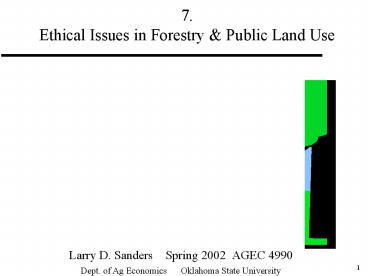7. Ethical Issues in Forestry & Public Land Use - PowerPoint PPT Presentation
1 / 16
Title:
7. Ethical Issues in Forestry & Public Land Use
Description:
update 9 jan 97 ... Ethical Issues in Forestry & Public Land Use Larry D. Sanders Spring 2002 AGEC 4990 – PowerPoint PPT presentation
Number of Views:23
Avg rating:3.0/5.0
Title: 7. Ethical Issues in Forestry & Public Land Use
1
7. Ethical Issues in Forestry Public Land Use
- Larry D. Sanders Spring 2002 AGEC 4990
Dept. of Ag Economics Oklahoma State
University
2
INTRODUCTION
- Purpose
- to understand the ethical issues related to
forestry and public land use - Learning Objectives
- 1. To review the history of US public forest
policy note the significance of the ethical
debate in the concepts of conservation and
preservation. - 2. To understand alternative value perspectives
and value factors for forests. - 3. To understand the differences in private and
public forest management. - 4. To become aware of other key factors in
forest resource management.
3
Forest/Public Land Policy
- Pinchot (Conservation) vs. Preservation (Muir)
vs. Unrestricted Development (Big Business) - 1891-Forest Reserve Act (public forest reserves
from public land Western US) - 1897-Forest Organic Act (establishes national
forest system for water flow timber
sustainability) - 1905-USFS established
- 1911-Weeks Act (okays purchase of private land
for national forests Eastern US)
4
Forest/Public Land Policy (cont.)
- 1916-National Park Organic Act (creates NPS
system to conserve scenery, wildlife, historic
objects) - 1960-Multiple Use Sustainable Yield Act (MUSYA)
(adds watersheds, recreation, wildlife, fishing,
hunting, soil concerns to national forests) - 1964-Wilderness Act (begins preservation of
unique natural areas) - 1968-Wild Scenic Rivers Act (preservation of
unique rivers)
5
Forest/Public Land Policy (cont.)
- 1974-Forest Rangeland Renewable Resources
Planning Act (RPA) (creates planning process) - 1976-National Forest Management Act (adds
economic, wildlife, wilderness recreational
uses to USFS planning) - 1980-Alaska National Interest Lands Conservation
Act (ANILCA)(adds 13 national parks, 16 wildlife
refuges, 56 mil. Ac. To wilderness system) - 1970s-1980s-added to wilderness system thru US
- 1990s-move to privatize some national forest areas
6
Classification of Forest Values(1)
1. Bengston, D. 1993
7
Value Perspectives in Forestry (Bengston in CS)
- Logger primary value is economic (utilitarian
ethic) - Professional ecologist primary value is for life
support (sustain ecosystem utilitarian ethic) - Local resident primary value is moral (intrinsic
ethic) - Artist primary value is aesthetic (intrinsic
ethic of existence of beauty)
8
Market Non-market Economic Valuation Applied to
Forests
- Use value
- Option value
- Existence value
- Bequest value
9
Market Non-market Economic Valuation of Forests
(continued)
- Use Value
- Market measurable (i.e., timber, development,
fee-based recreation) - Derive market supply (marginal costs) demand
(marginal benefits) to determine efficient level
of use - Non-market measurable (recreation use)
- Contingent valuation, hedonic pricing, etc.
- Option Value
- Non-market measurable (the right to use the
forest in the future) - Contingent valuation, etc.
10
Market Non-market Economic Valuation of Forests
(continued)
- Existence Value
- Non-market measurable (the intrinsic value
derived from knowledge that forest will exist in
perpetuity, regardless of use by future human
generations) - Contingent valuation, etc.
- Bequest Value
- Non-market measurable (the knowledge that future
generations will have use access to forest) - Contingent valuation, etc.
11
Private Forest Management
- Use depends solely on owner choice
- Profit motive usually rules decision making on
use (maximize net present value) - Owner typically restricts access to others
- While property rights evolve, democratic
government in market economy reluctant to impose
many restrictions on land use/access (takings)
12
Public Forest Management
- Use depends primarily on choices by public
public officials (elected appointed) - Multi-purpose use has evolved as primary purpose
for public forests in US--federal state
(maximize net present value) - Typical conflict
- Economic development vs. environmental protection
- Competing recreation uses
- Key concepts Public goods free riders, time
horizon
13
Key Factors in Forest Resource Management
- Preservation vs. Conservation vs. Development
- Intrinsic vs. Utilitarian vs. Utilitarian Ethics
- Forest Ecology
- Intrinsic vs. Utilitarian Ethics
- Private vs. Public Management
- Intrinsic Utilitarian Ethics
- Multiple Use
- Intrinsic vs. Utilitarian vs. Utilitarian
14
Forest Ecology
- Ecosystem
- Climax Community
- Soil Formation Nutrient Cycling
- Carbon Cycling
- Hydrological Cycle
- Ancient Forests
- Benefits
- Market (Wood derivatives, Recreation, Mining,
Grazing) - Nonmarket (Habitat, Amenities Option, Existence,
Bequest)
15
Multiple Use Forest Management
- 1. Quantity quality of other stands key to
benefits of specific stand (how unique is it?) - 2. Multi-Use Sustained Yield Act
(MUSYA)-1960-mandates USFS to manage both timber
non-harvest benefits (recreation, habitat,
etc.) - 3. Below-Cost Timber Salesinefficient
- 4. NPV of all multi-uses gt NPV without timbering
- 5. Old growth (Ancient forests) ESA critical
habitat Special Cases--Nonmarket value may be
higher in preservation
16
REFERENCES
- Bengston, D.N., The Nature of Value and the
Value of Nature, paper presented to People
Forests Meeting the Challenge of Tomorrow,
November 7-10, 1993.































